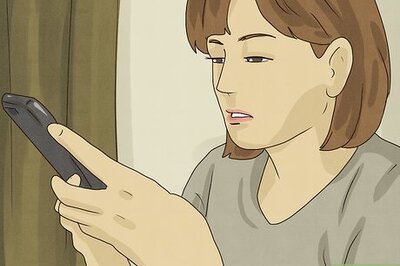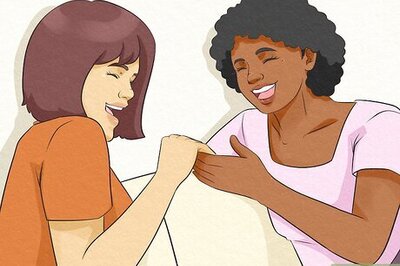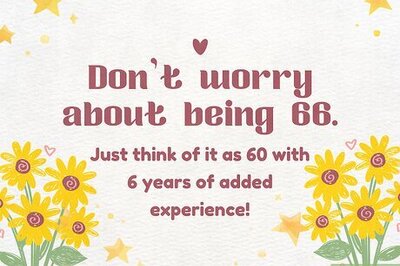
views
Every upper caste child grows up with a mind's eye image of the "achchut", the "untouchable", the "scheduled caste". The imagined Untouchable is perpetually filthy just as the Brahmin is perpetually pure. The imagined Untouchable is squalid in appearance and perpetually inferior. And his inferiority, like the inferiority of the young and of women, is sanctified not just by society, but by God. Today, many dalit writers argue that India will never be a modern society unless the Purusa-Sukta of the Rig Veda is re-written.
The Purusa-Sukta is the hymn which states that brahmins are born from the forehead of the creator, khsatriyas from the arm, vaishyas from the stomach and shudras from the foot. The dalits, or "ati-shudras", are the "un-born". They exist outside the body of the cosmic being, thus they are doomed to endless pariah status, however far they advance in education and wealth. In a society subliminally conscious of the Purusa-sukta, Ambedkarism is bound to fail.
"Democracy," BR Ambedkar wrote, "is essentially a form of society, not a form of government. Political democracy pre-supposes a democratic form of society." In a society which accepts that God Himself believes that some men are born inferior to others, simply providing opportunities to vote or form political parties is inevitably meaningless. Dalit historian Kancha Ilaiah has a suggestion. Just as the Vatican meets periodically to modernise catholicism, he says, the shankaracharyas should meet in conclave to modernise Hinduism. They should not only re-write the Purusa-sukta, but they should also decree that everyone, every woman, every tribal, every dalit, has the right to be priest of God and God is not the exclusive preserve of the brahmin.
The event will have tremendous symbolic value, provide a turbine charge to India's quest for modernity and Bhim Rao will at last be vindicated. Today paradoxically, Ambedkar's legacy poses a peculiar dilemma for the modern dalit. To take on the dalit mantle, to educate, organise and agitate for dalit rights, to set up statues of Ambedkar, to use the dalit as a voter, as say Mayawati has done, is to be radical soldier of empowerment. On the other hand, to neglect the avenue of dalitness and seek to merge with the mainstream would be to renege on the destined cause and risk social disdain from upper castes. Thus dalitness is both a political rallying cry as well as, at exactly the same time, a segregative device from the mainstream. Mayawati may be "free" but she's lonely.
K R Narayanan may have become president but a brahmin woman may never have married him. In the late '90s, B.N. Uniyal set off in search for a dalit journalist. He surveyed many newspapers and magazines but didn't find one. In fact most editors, invariably Hindu, upper caste and male became angry with him for carrying out such an "un-necessary" exercise. Among 686 journalists accredited to the government, 454 were upper caste. The remaining 232 did not carry their caste names and in a random sample of 47 not one was a dalit. Thus the dalit is trapped in certain designated enclaves. He is a politician. He may be a babu or even a lawyer or a teacher in a state school.
But a dalit Bollywood hero? A scriptwriter? An eminent lawyer, artist, model, musician, event manager, hotelier or tour guide? Never. The contemporary dalit (with very few exceptions) is imprisoned in the public sector, precisely because the attachment to caste is impossible to escape. Ambedkar statues have buried his larger message. Bhim Rao's children are still searching for the way to become activists for "democratisation" rather than simply for "dalitisation", the former being a battle in which women, youth and adivasis would be allies.
Perhaps for the renewal of Indian society, to create a spiritual awakening and to revitalize our culture, indeed to become a social democracy even as we are a political democracy, we need, as a conscientious public, to re-write the purusa sukta. Imagine what a thrill such an exercise will send out through our land. Imagine the amazing symbolic power of such a revision. Imagine the massive cultural and social renaissance it will create if the shankaracharyas or the heads of mathas or the mahamandaleswars at Varanasi all decided that for the sake of a massive spiritual and democratic symbol, they will rewrite this ancient yet fundamentally unjust hymn. Imagine the power of change.About the AuthorSagarika Ghose Sagarika Ghose has been a journalist for 20 years, starting her career with The Times of India, then moving to become part of the start-up team...Read Morefirst published:February 09, 2006, 13:46 ISTlast updated:February 09, 2006, 13:46 IST
window._taboola = window._taboola || [];_taboola.push({mode: 'thumbnails-mid-article',container: 'taboola-mid-article-thumbnails',placement: 'Mid Article Thumbnails',target_type: 'mix'});
let eventFire = false;
window.addEventListener('scroll', () => {
if (window.taboolaInt && !eventFire) {
setTimeout(() => {
ga('send', 'event', 'Mid Article Thumbnails', 'PV');
ga('set', 'dimension22', "Taboola Yes");
}, 4000);
eventFire = true;
}
});
window._taboola = window._taboola || [];_taboola.push({mode: 'thumbnails-a', container: 'taboola-below-article-thumbnails', placement: 'Below Article Thumbnails', target_type: 'mix' });Latest News
There is a wonderful work on the Indian caste system called Homo Hierarchicus by Louis Dumont. Some critics have called Dumont's book an oversimplification, others have called it Orientalist, but one of the book's most important contributions is the argument that the caste system is not just a social arrangement. In fact, the caste system is a system of ideas. The idea of hierarchy, according to Dumont, lies at the core of Indian society. Hierarchy as based on age, gender and caste, hierarchy which is sanctified by religion itself. "Greater" and "lesser", the two categories that are crucially antithetical to a modern egalitarian society, are in fact embedded in Hindu social consciousness.
Every upper caste child grows up with a mind's eye image of the "achchut", the "untouchable", the "scheduled caste". The imagined Untouchable is perpetually filthy just as the Brahmin is perpetually pure. The imagined Untouchable is squalid in appearance and perpetually inferior. And his inferiority, like the inferiority of the young and of women, is sanctified not just by society, but by God. Today, many dalit writers argue that India will never be a modern society unless the Purusa-Sukta of the Rig Veda is re-written.
The Purusa-Sukta is the hymn which states that brahmins are born from the forehead of the creator, khsatriyas from the arm, vaishyas from the stomach and shudras from the foot. The dalits, or "ati-shudras", are the "un-born". They exist outside the body of the cosmic being, thus they are doomed to endless pariah status, however far they advance in education and wealth. In a society subliminally conscious of the Purusa-sukta, Ambedkarism is bound to fail.
"Democracy," BR Ambedkar wrote, "is essentially a form of society, not a form of government. Political democracy pre-supposes a democratic form of society." In a society which accepts that God Himself believes that some men are born inferior to others, simply providing opportunities to vote or form political parties is inevitably meaningless. Dalit historian Kancha Ilaiah has a suggestion. Just as the Vatican meets periodically to modernise catholicism, he says, the shankaracharyas should meet in conclave to modernise Hinduism. They should not only re-write the Purusa-sukta, but they should also decree that everyone, every woman, every tribal, every dalit, has the right to be priest of God and God is not the exclusive preserve of the brahmin.
The event will have tremendous symbolic value, provide a turbine charge to India's quest for modernity and Bhim Rao will at last be vindicated. Today paradoxically, Ambedkar's legacy poses a peculiar dilemma for the modern dalit. To take on the dalit mantle, to educate, organise and agitate for dalit rights, to set up statues of Ambedkar, to use the dalit as a voter, as say Mayawati has done, is to be radical soldier of empowerment. On the other hand, to neglect the avenue of dalitness and seek to merge with the mainstream would be to renege on the destined cause and risk social disdain from upper castes. Thus dalitness is both a political rallying cry as well as, at exactly the same time, a segregative device from the mainstream. Mayawati may be "free" but she's lonely.
K R Narayanan may have become president but a brahmin woman may never have married him. In the late '90s, B.N. Uniyal set off in search for a dalit journalist. He surveyed many newspapers and magazines but didn't find one. In fact most editors, invariably Hindu, upper caste and male became angry with him for carrying out such an "un-necessary" exercise. Among 686 journalists accredited to the government, 454 were upper caste. The remaining 232 did not carry their caste names and in a random sample of 47 not one was a dalit. Thus the dalit is trapped in certain designated enclaves. He is a politician. He may be a babu or even a lawyer or a teacher in a state school.
But a dalit Bollywood hero? A scriptwriter? An eminent lawyer, artist, model, musician, event manager, hotelier or tour guide? Never. The contemporary dalit (with very few exceptions) is imprisoned in the public sector, precisely because the attachment to caste is impossible to escape. Ambedkar statues have buried his larger message. Bhim Rao's children are still searching for the way to become activists for "democratisation" rather than simply for "dalitisation", the former being a battle in which women, youth and adivasis would be allies.
Perhaps for the renewal of Indian society, to create a spiritual awakening and to revitalize our culture, indeed to become a social democracy even as we are a political democracy, we need, as a conscientious public, to re-write the purusa sukta. Imagine what a thrill such an exercise will send out through our land. Imagine the amazing symbolic power of such a revision. Imagine the massive cultural and social renaissance it will create if the shankaracharyas or the heads of mathas or the mahamandaleswars at Varanasi all decided that for the sake of a massive spiritual and democratic symbol, they will rewrite this ancient yet fundamentally unjust hymn. Imagine the power of change.




















Comments
0 comment